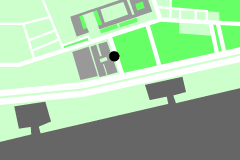



A collaborative project involving designers from around the world, Catalysts! deals with the relevance and impact of communication design in contemporary culture.
Design's visual languages have become engraved into our collective perception. Graphic designs by professionals as well as public expressions by amateurs share a common reference in a global visual thesaurus, which is being distributed through an ever expanding network of connected media.
Catalysts! underlines the diversity of this symbolic culture, highlighting designs and statements which consciously use it and contribute to it.
 + Info: http://www.culturecatalysts.org
+ Info: http://www.culturecatalysts.org
|
 |




Centro Cultural de Belém
Praça do Império
1400-206 Lisboa
H 10h - 19h (closed on mondays)
T +351 213 612 400
E ccb@ccb.pt
W http://www.ccb.pt
Bus
14, 27, 28, 29, 43, 49, 51, 73, 112, E15, E17
Tram
15, 17

Tickets for sale at CCB
Admission: 3,50 €
< 12 years: 0,50 €
50% discount for students, holders of CCB Teachers' Card and senior citizens over 65.
Concessions not cumulative.
|

BELIEVE
Design: Ed Annink [NL]
An average of 3000 public messages a day are thrown at the inhabitants of today’s modern cities. All of these advertisements, road signs, do and don’t notes, directions, corporate and public communications want one thing: that you believe what they say. In an open and democratic society, it is crucial that both designers and citizens remain critical. Rather than becoming sheepish followers or believers, they can act as mature and visually literate participants of communication culture. Designers become catalysts when they assist the public in taking a second critical look, beyond merely accepting or rejecting the messages that surround them.

SEDUCE
Design: Fernando Brízio [PT]
Communication equals seduction. A graphic design rarely communicates neutral information; it tries to seduce you into reading the message and positively respond to its contents. But seduction can be more than just saying ‘buy me, please!’ The designs in this section seduce by addressing the public as intelligent readers of cultural information. By triggering their audience’s social concerns, challenging their associative powers, counteracting mindless concepts, designers act as cultural catalysts. Beyond the message, the design seduces you to relate it to your own culture and society. Thus, it helps you to design a bridge between the message’s content and yourself.

INFORM
Design: Pierre di Sciullo [FR]
As soon as any information is designed, it becomes interpreted and thus subjective. Even the most ‘objective’ of signs, letters, can become cultural icons in their own right when designed with a specific cultural intention in mind. Similarly, such seemingly neutral imagery as street signage can ground itself visually in the cultural history and identity of its environment. This section will show a broad range of designs using the visual languages of information design: graphs, diagrams, pictograms, etceteras. The main message of these designs, however, is not necessarily the information, but the way it has been constructed as cultural expression.

ENGAGE
Design: Erik Adigard, M-A-D [FR]/[US]
A good design is not a neutral answer to a brief; it is essentially a criticism of the contents for which it has been produced. In this section we show designs that act out this critical position. They comment on culture and society using the images and visual codes designers have collectively developed during a century of communication design. Popular culture, too, expresses itself more and more in these graphic codes. The most direct way of communicating your engagement with the world around you is to mobilize its native graphic languages — everyone can now design and publish their own messages.

MORAL PANIC - the shattered brain of a TV addict
Design: Rob Schröder [NL]
If there was ever a TV addict, it would be designer and filmmaker Rob Schröder. For years he watched television on three screens at a time and recorded on tape what struck him as fascinating, important, weird, disgusting or downright shocking. In Moral Panic he edited forty years of viewing experience into a mind blowing collage of iconic images, freakish material and forgotten faces. Moral Panic is a fast paced journey that makes you wonder if the serious and the sleaze have become the same thing. Moral Panic is a requiem for an addiction — the burial of a medium.

HISTORICAL TIMELINE
Design: Jan van Toorn [NL]
The visual languages of graphic and communication design have developed over slightly more than a century. During this period, some designers and movements have set off radical innovation, followed by others who have developed new uses and applications for existing forms. Change and establishment have taken turns, from the radical 1910s, through the maturing 1930s, the new élan of the 1960s, to the global style of the 1980s and 1990s. The four kiosks of our ‘historical timeline’ form an exhibition within the exhibition. They highlight the icons of design and visual culture that have shaped the thesaurus of communication design.
|

Curator Max Bruinsma [NL]; Assistant Curator Willem van Weelden [NL]; Design Supervision Ontwerpwerk, multidisciplinary design [NL]; Exhibition Concept and Design Believe: Ed Annink [NL]; Seduce: Fernando Brízio [PT]; Inform: Pierre di Sciullo [FR]; Engage: Erik Adigard, M-A-D [FR]/[US]; Moral Panic: Rob Schröder [NL]; Historical Timeline: Jan van Toorn [NL]; Video Projections Rob Schröder [NL]; Ideas of Visual Language Tjebbe van Tijen [NL]; Production Ana Casaca, CCB; Bruno Sequeira, Experimenta; Production Assistants Inês Barros, Experimenta; Maria Azevedo, Experimenta; Fee Pfeiffer; Wendela Hubrecht; Co-production Experimenta [PT] / CCB, Museu do Design [PT]; Specific Support Mondriaan Stichting [NL]; Viarco [PT];
|


